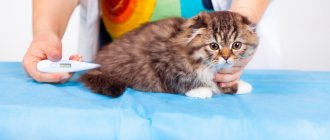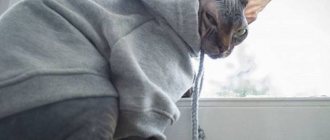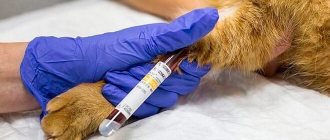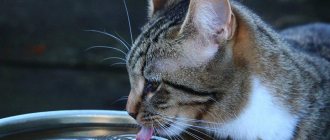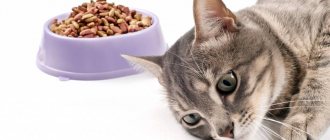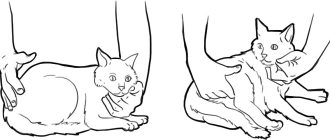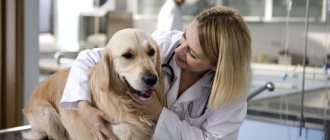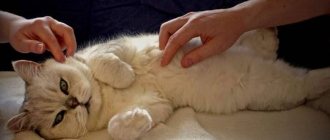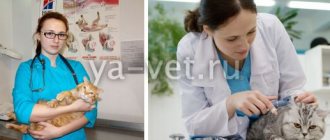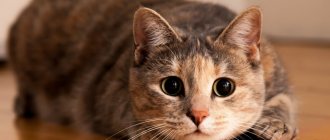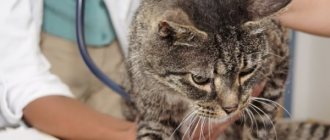The process of giving birth to kittens is not an easy task. At this time, there is always a possibility that some stages will not go as nature planned. Simply put, there is a certain danger of developing postpartum pathologies. However, a cat’s birth usually ends quite happily, and therefore there is no need for veterinary care. Despite this, every owner should be aware of the manifestations of the main postpartum pathologies in order to immediately contact a veterinary specialist if necessary.
Postpartum inflammation of the uterus
This is one of the most common postpartum complications, occurring not only in cats, but also in many other mammals (including humans). This is the name of a pathology in which the inner lining of the uterus (endometrium) becomes inflamed. It develops a few days after birth and can occur in acute or chronic form. In cats, due to certain characteristics of their body, this disease is especially severe and often leads to very negative consequences (up to the need for surgical removal of the uterus).
Endometritis can be a consequence of abortion, birth trauma, improper or rough obstetric care. There are also cases described (albeit very rare) when pathogenic microflora enters the uterine cavity where there is already a focus of inflammation (for example, a large abscess). In addition, situations are much more common when these complications after childbirth (including very severe ones) develop against the background of various hormonal pathologies.
This pathology itself is extremely dangerous due to severe intoxication and a very high probability of developing a septic process: if pathogenic microorganisms enter the general bloodstream, this will lead to the appearance of inflammatory foci throughout your pet’s body.
Remember, even with a simple suspicion of inflammation of the uterus, the cat should be shown to an experienced veterinarian as soon as possible.
Clinical picture
Symptoms usually appear between 12 and 96 hours after the kittens are born. In some cases, this period may extend for several weeks. Regardless of the incubation period, the clinical picture is almost always the same:
- The abdomen may noticeably swell and sag. With severe acute endometritis, it sometimes seems that the cat is pregnant again.
- In the purulent-necrotic form of the disease, a very unpleasant, hard-to-tolerate smell of rot appears from the cat.
- A dark green or yellowish-green exudate is released from the genitals. The smell, as we have already indicated above, is not the most pleasant.
- Apathetic state.
- Intermittent fever.
- Vomiting (indicates very severe intoxication).
- Diarrhea.
- A dark rash may appear on the skin in the genital area.
- In severe cases, dehydration quickly develops, which increases intoxication.
- Milk synthesis slows down significantly and its volume decreases.
- Depression.
- Loss of appetite.
- A sick cat in many cases completely stops caring for kittens. She simply does not have the strength for such a difficult event.
How long can a cat go without eating, what are the dangers of starvation?
These are approximate dates, taking into account that the animal drinks enough these days. Longer fasting or fasting while refusing to drink is dangerous for the life of a pet.
A kitten under 6 months of age can die within 24 hours of fasting, so if the kitten does not eat, it must be force-fed.
In addition to the risk of death, refusing to eat can cause the following health problems:
- severe weight loss;
- exacerbation of any chronic diseases;
- avitaminosis.
Predisposing factors
Regardless of the form of endometritis, its development is caused by the entry of pathogenic or conditionally pathogenic microflora into the uterine cavity.
Of course, above we have already mentioned cases of pathology, the appearance of which was caused by hormonal imbalances... But in any situation, all this only contributes to the “rooting” of microbes, and the following negative factors lead directly to endometritis:
- Sexually transmitted diseases (yes, they occur in cats too).
- Prolonged, difficult labor.
- Large births, as well as congenital anatomical pathologies of kittens.
- Rough or inept obstetric care, poorly sterilized obstetric instruments.
- Natural or medical abortion.
- Retention of placenta, or the presence of dead fetuses in the uterine cavity. For cats, this pathology is extremely dangerous, and it leads not only to endometritis, but also to the development of septic processes (and they are already fraught with death).
Diagnostic measures
The veterinarian will need a complete medical history of the birth (how it went, whether the animal received obstetric care, etc.). A thorough medical examination is required to confirm/refute acute metritis based on clinical signs.
Timely diagnostic tests play a huge role in diagnosis. These include: complete blood count, blood chemistry profile, serology and urinalysis.
The most revealing may be a complete microscopic blood test : by the number of leukocytes, you can determine how intense the inflammatory process is in the animal’s body. In addition, a microscopic examination can show whether pathogenic microflora has appeared in the general bloodstream (i.e., whether sepsis has developed).
A urine test will allow the veterinarian to know how well the animal's kidneys are working and whether the cat has become severely dehydrated.
Ultrasound and fluoroscopic examination of the uterus itself is also indicated . This helps to visually assess the condition of the organ, the presence or absence of retained placenta, dead fetuses, blood or exudate. If there is discharge from the external genitalia, a specialist will definitely take a sample of the exudate for microscopic examination and sowing of the pathological material onto nutrient media. This will help, firstly, to identify the specific pathogen. Secondly, this way the specialist will find out which drug should be used to eliminate this particular case of infection.
Therapeutic techniques
- To help the animal's body cope with the consequences of dehydration, as well as intoxication, Ringer's and glucose solutions . This is an important part of the treatment of any severe case of postpartum endometritis. In addition, timely administration of intravenous infusions helps protect the kidneys.
- Antibiotics . Ideally, drugs are prescribed only based on the results of growing a culture of pathogens on nutrient media. If for some reason this cannot be done, broad-spectrum antibiotics are prescribed. But it is still better to identify a specific pathogen. It is possible that an inexpensive and “light” drug will be suitable for its destruction.
- The most difficult treatment will be in cases where it comes to the development of a septic process. In such situations, the cat urgently needs competent veterinary care, since the likelihood of death is very high. Loading doses of broad-spectrum antibiotics intravenously, drugs that support cardiac and respiratory activity, and intravenous infusions are required
- Surgical intervention . If the uterus is greatly enlarged and there is a suspicion of pyometra, the uterus must be urgently removed. In the event that the owners or veterinarians did not inspect it, and there is an afterbirth or dead fruits left in the organ cavity, it must be removed immediately, since any delay guarantees the development of a severe septic process. Spaying is also recommended. In some cases (when the cat has a certain breeding value) they resort to surgical cleansing of the uterine cavity. Please note that no one can give any guarantee of the success of this operation. Most likely, the cat will still develop severe metritis, after which bearing full-fledged kittens may be impossible.
Please note that after antibiotic therapy, the animal will most likely develop dysbiosis due to the death of the symbiotic intestinal microflora.
As a consequence, constipation and all other problems arising from the fact of constant intoxication of the body by deposits of feces. It wouldn't hurt to give her probiotics.
You also need to remember the need to isolate newborn kittens from their mother: antibacterial drugs or pathogens can enter their digestive tract. In any case, this will not lead to anything good. And further. Even in cases where the pet received quality veterinary care on time, it is far from certain that its reproductive function will be fully restored.
What to do if the cat doesn't eat
In each specific case, when a cat has stopped eating its favorite food, the behavior of the owners and treatment should be individual and justified.
The first rule is that you should not try to force feed an animal until you have found out the exact reason for the hunger strike.
Feeding with a syringe or spoon is allowed only as prescribed by a doctor. Only a veterinarian can make an accurate diagnosis. If the doctor identifies a disease, he will prescribe treatment.
If your cat refuses to eat for other reasons than illness, there is no need to panic – the animal’s appetite will return without human intervention.
Showing care and love for your furry beauty is not limited to just proper feeding and proper care. The drinking regime plays an important role in maintaining the health and vitality of the animal. Therefore, when the owner notices that the cat is not drinking water, what to do is a major concern. In this situation, it is important not only to understand the reason for this behavior, but also to take measures to prevent dehydration in the pet.
Read in this article
Mastitis
Mastitis is inflammation of the mammary glands . There are many varieties of this pathology, but serous mastitis is more common in cats, sometimes purulent. In the most severe cases, often leading to death, necrotic and fibrous types of pathology are noted.
There can be many causes of mastitis. In the most typical situations, inflammation is caused by pathogenic and conditionally pathogenic microflora entering the milk alveoli. The combination of hormonal changes during and after pregnancy, as well as the sharp teeth of growing kittens, is an ideal combination for the development of the inflammatory process.
In most cases, the mother’s immune system is quite capable of defeating the infection on its own, but in situations where the immune system is weakened for some reason, the body is no longer able to cope with the microbes. Accordingly, the older the cat, the greater the likelihood of developing mastitis (immunity under the influence of age-related factors is greatly weakened).
Clinical picture
All mastitis, regardless of their etiology, is accompanied by swelling of the affected lobes of the mammary gland. In cats, the problem is usually limited to one or two nipples. When they are palpated, severe pain is revealed, the animal becomes irritable and may behave inappropriately. As a rule, the cat stops feeding the kittens, since due to the inflammatory process in the mammary gland, fulfilling parental duties becomes extremely painful.
When you press on the nipple of the affected area, not a drop of milk comes out , but you may notice drops of colorless liquid or pus. In some cases, kittens manage to “strain” milk from areas affected by the inflammatory process, which leads to extremely serious consequences for them. Pathogenic and conditionally pathogenic microflora enter the digestive system of babies, causing kittens to develop diarrhea. In just a few hours, the entire litter may die from intoxication and dehydration.
Therapeutic techniques
First, even before starting treatment, it is necessary to isolate the kittens from their mother. As we said above, eating mastitis milk will not lead to anything good. Secondly, it is necessary to obtain a sample of exudate for the purpose of its further microscopic examination and seeding of pathological material on nutrient media. In addition, in complex and doubtful cases, a biopsy is recommended: using this technique, you can find out what condition the breast tissue is in and which therapeutic methods will be most effective in a particular case.
As for the specific treatment, as in the previous case, it is not particularly original: the animal is urgently prescribed loading doses of broad-spectrum antibiotics. In some situations, antibiotics are dissolved in a solution of novocaine and the resulting product is used to inject areas of inflammation. If fibrous, severe purulent, or necrotizing endometritis is involved, the veterinarian may decide to surgically remove the dead tissue. Naturally, in such cases, all this is also accompanied by the introduction of loading doses of broad-spectrum antibiotics.
Let us warn you once again that when treating mastitis, it is imperative to isolate kittens from their mother cat! Babies will either die from diarrhea caused by drinking mastitis milk, or from the same diarrhea resulting from the death of all beneficial microflora (due to the action of antibiotics).
The main reasons why a cat refuses to eat
- Stress.
- Changing your diet.
- Thermoregulation.
- Sexual instinct.
- Pregnancy.
- Postpartum period.
- Consequences of anesthesia.
- Parasites.
- Oral diseases.
- Poisoning.
- Foreign body and fur in the stomach and intestines.
- Viral infection.
- Diseases of the liver, kidneys and urolithiasis.
Cats are exposed to stress no less, and perhaps even more than people. Moving to a new place of residence, a new bowl, rearranging the room, renovations, a business trip for the owner, or mood swings of the owner - all these are stressful situations for the animal.
Even the arrival of guests or a quarrel between family members can affect the cat’s well-being.
During stress, the cat is not active, she has an apathetic mood, she does not want to play with the owner, she eats poorly or refuses to eat at all. In such a situation, there is no need to force the animal to eat; refusing food for a couple of days is the norm.
Increased attention to the cat from family members, affectionate treatment, and new toys help in stressful situations. In severe cases, consultation with a veterinarian is necessary, who can prescribe sedatives to the animal.
But be careful: the cause of stress may be the onset of an illness.
Changing your diet
New food is stressful in itself. Cats are very picky eaters and are sensitive to any change in diet. A sudden transition from one type of food to another, or a change in the brand of dry or wet food, can lead to the animal going on a hunger strike.
The animal does not understand that the new food is of better quality and cannot appreciate the efforts of the owner. The cat is accustomed to a certain food, so it declares a “boycott” on any unfamiliar food.
Monitor the condition of the animal; if the cat looks healthy and drinks enough water, then you should not worry too much about such a “hunger strike”.
But to prevent this from happening, the transition to a new food must be done gradually, adding it in small portions to the usual food.
Thermoregulation
In simple words, the animal is hot and does not want to eat. This happens in summer in hot weather or in winter in apartments with central heating. Your pet is lethargic, lies down all the time, doesn’t want to do anything, eats poorly, but drinks a lot.
In unbearable heat, a cat may not eat from a day to three, and in between, eat small portions. This is normal because the more your cat eats, the more heat her body will produce while digesting the food and it will be more difficult for her to cope with the heat.
The owner need not worry. The main thing is that the cat always has enough fresh water.
Sexual instinct
Hormones released in a cat's body before estrus can affect the cat's appetite. Particularly sensitive cats lose their appetite a week before estrus and spend all their energy sleeping and loudly meowing for a partner.
Appetite may return with the onset of estrus or only after it ends. It happens that a cat refuses to eat for several days if a “walking” cat lives next door.
It is recommended to show animals that are experiencing too much heat to a veterinarian so that he can examine the animal’s hormonal levels. After this examination, your doctor may recommend spaying or neutering your pet.
Pregnancy
Logically, a pregnant cat should have an increased appetite in order to feed itself and its future offspring. But it happens that pregnant cats refuse to eat or their appetite decreases.
Such animals must be urgently shown to a veterinarian so that he can rule out the presence of serious diseases.
Postpartum period
In the first days after birth, cats often do not eat. There may be several reasons for this behavior: the cat is afraid to leave the kittens alone, the young cat is experiencing postpartum stress or is resting after a difficult birth.
If your cat refuses to eat for more than one day, you need to sound the alarm and contact a specialist. Urgent consultation is needed if the cat is breathing heavily, has a fever, is vomiting or has loose stools.
Fleas and worms have a serious negative impact on a cat's body. The discomfort they cause can be one of the reasons for loss of appetite. To prevent this, it is necessary to regularly treat the animal against parasites and monitor the cleanliness of the home. Vomiting and diarrhea that appear simultaneously with loss of appetite also indicate the possible presence of helminths.
Oral diseases
Missing teeth, caries, tartar and other dental problems are common reasons why a cat does not eat and only drinks water. Experiencing discomfort when absorbing and chewing food, the animal eventually refuses to eat.
To avoid this kind of problem, you need to regularly care for your cat’s oral cavity and choose the right type of food.
Poisoning
Cats and cats have a very well developed gag reflex and many owners do not worry when the animal gags. With their help, pets get rid of swallowed hairballs.
If the cat is active after vomiting, there is no need to worry. If weakness, muscle tremors, lethargy and drooling are added to vomiting, this is poisoning. It is urgent to find out what the cat ate so that the veterinarian can quickly prescribe effective treatment. Severe poisoning from poisons or chemicals can lead to the death of your pet.
Foreign body or fur in the stomach and intestines
Intestinal obstruction caused by a foreign body or hair in the intestine can lead to the death of the animal. Obstruction is caused by: sausage skins, bones, hairballs, and any other accidentally swallowed objects.
During obstruction, gastric juice is released and stagnates in the stomach and intestines. The animal reacts to this condition by refusing food, vomiting, and not going to the toilet. The cat's body becomes dehydrated and the animal becomes weaker. When your pet is truly ill, all appointments should be made by a veterinarian after examining the pet.
Viral infection
Lack of appetite, sneezing, fever, and discharge from the nose and eyes are often signs of a viral infection.
The diagnosis must be made by a doctor after a blood test. Self-medication of viral infections is risky, especially if the animal is not vaccinated. During a viral infection, a cat may refuse food for up to three days.
Liver, kidney and urolithiasis
The most serious causes of a cat’s “hunger strike” are considered to be diseases of the internal organs: liver, kidneys and genitourinary system.
The first symptoms of these diseases: lethargy, constant urge to urinate, refusal of your favorite food, blood in the urine.
Proper nutrition is the best prevention against this kind of disease. But only a veterinary specialist should diagnose and prescribe treatment!
Consequences of anesthesia
During the postoperative period, cats can remain offline for up to two days. This is a consequence of the action of drugs that induce narcotic sleep. They relax all body functions. This especially affects motor and digestive functions.
In addition, the swallowing reflex is impaired. Appetite returns on its own 5-8 hours after complete recovery from anesthesia.
Vaginitis
A very common postpartum pathology. This is the name for inflammation of the vaginal tissue . The reasons are varied, but they are not particularly “cunning”: during childbirth, it often happens that the mucous membrane of the genital organs is damaged, as a result of which the likelihood of pathogenic and conditionally pathogenic microflora penetrating there sharply increases. This is almost always how cases of inept obstetric care end.
If you do not have the appropriate experience and knowledge, do not try to help your pet in labor (most likely, she does not need it). You are unlikely to be able to help, but you can do a lot of harm!
The clinical picture is not very specific, which is why vaginitis is often confused with endometritis. The cat becomes lethargic, does not want to take care of the kittens, and a large amount of exudate (often very odorous) is released from its external genitalia. In addition, upon external examination, swelling of the genital organs and pain when attempting to palpate them may be detected.
Therapy is also not particularly rich in options - broad-spectrum antibiotics are prescribed in loading doses. Preferably intravenously. Ringer's and glucose solutions are administered in the same way, as they help relieve intoxication (and in case of severe inflammation, it will certainly appear).
Reduced calcium levels in the blood
This pathology is better known as “postpartum eclampsia.” The condition is very serious, there is a high probability of death. Caused by a violation of calcium metabolism in the animal's body . Considering how important this macronutrient is for the nervous system, the consequences of its deficiency can be extremely serious. Convulsions and seizures occur, which are often confused with epilepsy.
The insidiousness of eclampsia is that it can appear either immediately after childbirth or a few days later. Intermittent fever and temporary paralysis of the limbs may also occur. In the mildest cases, it does not lead to seizures, but the cat’s gait becomes wooden, the animal walks as if on stilts.
Why does a lack of calcium develop in the body? Directly during pregnancy, the animal's body consumes a huge amount of this compound to build the skeletal tissue of the fetus, and soon after birth a lot of it goes into milk.
It should be remembered that in the animal’s body calcium is available in two forms: labile (found in blood plasma) and stable (in bone tissue, teeth). If there is not enough labile macroelement, the body begins to massively use reserves of stable calcium, which in the long term can lead to osteoporosis. In addition, it takes a lot of time to remove the desired element from bone tissue.
Even in cases where an animal’s food contains a sufficient amount of calcium, it is far from certain (especially in the case of diseases of the digestive system) that it can be absorbed at a sufficient speed. Actually, as a result of the combination of all these unfavorable factors, eclampsia develops.
As we said above, this may not happen immediately: cases have been described when a cat collapsed in a seizure a month after giving birth. The main risk factor is first birth. The more kittens in the litter and the larger they are, the higher the likelihood of pathology occurring (and much more).
It is believed that some cats are more predisposed to this pathology initially (this often happens with animals suffering from hormonal pathologies). If your pet has had symptoms of postpartum eclampsia at least once, then during the next birth all this can most likely happen again! So in such situations, we strongly advise you to agree in advance with the veterinarian about his constant presence at the birth. It definitely won't get any worse.
What to do and what to do?
Firstly, immediately call a veterinarian at the first suspicion of eclampsia. You won’t be able to do anything on your own, but you will only waste valuable time. Secondly, it is necessary to immediately provide the cat with complete rest. Note that it is necessary to protect the animal not only from various noises, but also from bright, irritating light.
Immediate administration of approximately 3 ml of calcium borogluconate is required, restoring normal calcium levels in the blood. Administration of the drug should be repeated approximately every hour (in severe cases - once every half hour) until symptoms disappear completely. Please note that you cannot administer more than 10 ml of borgluconate in three to four hours. Some veterinarians also recommend administering magnesium sulfate (magnesia) during the acute period.
Let us warn you right away that all dosages must be determined by a doctor, based on the weight and immediate condition of the animal. You shouldn't do this yourself.
Immediately discuss with your veterinarian how and what you should feed your animal for the first time after the seizures have stopped. At least once a week, it will be necessary to take blood: the specialist will know whether your pet’s body has enough calcium, and whether eclampsia should recur.
Injuries
A very diverse group of postpartum pathologies. This includes both “simple” bleeding that develops due to birth injuries to the genital organs, as well as more serious cases. In particular, with large fetuses, as well as due to congenital anomalies of the fetus, fractures of the pelvic bones are quite possible. Or, even worse, uterine prolapse (a deep red “bag” sticks out from the animal’s genitals).
All these pathologies have one thing in common - a strong pain reaction and the release of large volumes of blood. If you see that your pet is bleeding and suffering from unbearable pain, call the vet immediately.
Postnatal injuries cannot be cured without immediate surgery.
Should you take your cat to the vet yourself? Complex issue. Most likely, it is better to wait for a specialist, since without the appropriate skills such transportation will end sadly for the animal.
